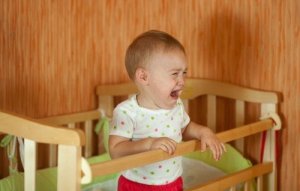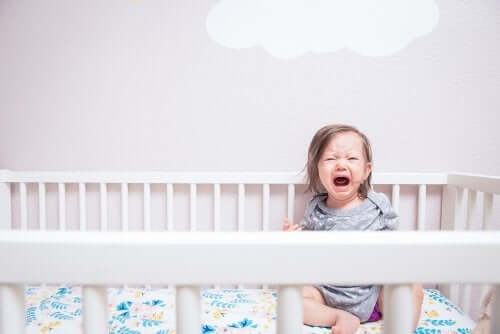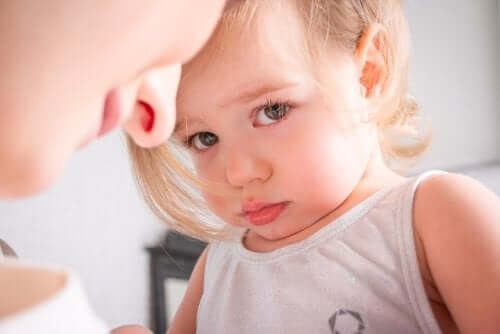Separation Anxiety in Babies: What You Should Know


Written and verified by the psychologist María Alejandra Castro Arbeláez
The anxiety and restlessness that manifest in a baby who’s separated from their parents is what’s understood as separation anxiety. It’s an instinct, as the baby considers separation a danger or threat to their safety. In other words, separation anxiety in babies is the fear they feel when they’re separated from their attachment figures.
Is separation anxiety in babies normal?
Separation anxiety in babies usually starts approximately when they’re eight months old and can last until they’re 14 to 18 months old. Psychologist Kathleen Stassen states that separation anxiety in babies is normal during their first year of life.
This anxiety intensifies until they’re about two years old and then decreases. However, she warns that if it continues until age three, it’s possible that the child suffers from an emotional disorder.
Mary Ainsworth’s Strange Situation procedure
As we explained above, the anxiety that manifests in babies when they separate from their mother is a normal phenomenon. Some theoretical proposals even propose it’s a good sign.
Mary Ainsworth, in her Strange Situation experiment, analyzed the reaction of babies when their mothers went away and left them alone or with another unknown person. From it, she developed a classification of patterns of attachment: secure, anxious-avoidant, insecure, anxious-ambivalent/resistant, insecure, and disorganized/disoriented.
According to this theory, in the healthiest type, secure, babies cry and protest when they’re separated from their mother. In other words, babies manifest anxiety when separated from their mother, which Ainsworth considers a sign of healthy attachment.

Strategies to help your baby through separation anxiety
- Tell your baby you’re going to leave. Sneaking out without saying goodbye to your child and not showing them that you’ll be away can make things worse. Your baby will feel confused and insecure when they realize you’re not around and may suffer more in the next absence.
- Brief farewells. When you’re going to leave, use a toy as a distraction and say goodbye quickly. Extending the farewell, for example, with a long embrace, can be assumed as the baby as an alarm signal.
- Normalize the absence. Try not to overdo it with goodbyes. In other words, stay calm and smile. This will give your baby more security, which means they’ll stop crying after a few minutes of your absence.
The stepladder approach
This approach is a step-by-step way to help babies and children overcome anxiety. It consists of helping your child deal with small challenges before tackling them with other challenges that may be more terrifying for them. It’s based on gradual exposure and encourages children to face their fears rather than avoid them:
- It helps your child get used to dealing with situations that cause them anxiety.
- They face their fears and learn to overcome them.
- They learn to use and implement the skills they learned in similar situations.
- Sense of progress as they go.
“Do not avoid your children the difficulties of life, teach them rather to overcome them.”
– Louis Pasteur –
In summary, separation anxiety in babies is a logical phenomenon and a normal part of development. For a baby, their mother is everything and, from the point of view of survival, anxiety at this stage makes total sense.

However, you need to know how to drive this anxiety so it doesn’t lead to an anxiety disorder. Preparation, brief and routine goodbyes, and the passage of time are the best ways to cope with separation anxiety in babies.
Once your baby observes that you always come back, they’ll realize that you’re not abandoning them. This will help them feel increasingly confident and independent in your absence.
The anxiety and restlessness that manifest in a baby who’s separated from their parents is what’s understood as separation anxiety. It’s an instinct, as the baby considers separation a danger or threat to their safety. In other words, separation anxiety in babies is the fear they feel when they’re separated from their attachment figures.
Is separation anxiety in babies normal?
Separation anxiety in babies usually starts approximately when they’re eight months old and can last until they’re 14 to 18 months old. Psychologist Kathleen Stassen states that separation anxiety in babies is normal during their first year of life.
This anxiety intensifies until they’re about two years old and then decreases. However, she warns that if it continues until age three, it’s possible that the child suffers from an emotional disorder.
Mary Ainsworth’s Strange Situation procedure
As we explained above, the anxiety that manifests in babies when they separate from their mother is a normal phenomenon. Some theoretical proposals even propose it’s a good sign.
Mary Ainsworth, in her Strange Situation experiment, analyzed the reaction of babies when their mothers went away and left them alone or with another unknown person. From it, she developed a classification of patterns of attachment: secure, anxious-avoidant, insecure, anxious-ambivalent/resistant, insecure, and disorganized/disoriented.
According to this theory, in the healthiest type, secure, babies cry and protest when they’re separated from their mother. In other words, babies manifest anxiety when separated from their mother, which Ainsworth considers a sign of healthy attachment.

Strategies to help your baby through separation anxiety
- Tell your baby you’re going to leave. Sneaking out without saying goodbye to your child and not showing them that you’ll be away can make things worse. Your baby will feel confused and insecure when they realize you’re not around and may suffer more in the next absence.
- Brief farewells. When you’re going to leave, use a toy as a distraction and say goodbye quickly. Extending the farewell, for example, with a long embrace, can be assumed as the baby as an alarm signal.
- Normalize the absence. Try not to overdo it with goodbyes. In other words, stay calm and smile. This will give your baby more security, which means they’ll stop crying after a few minutes of your absence.
The stepladder approach
This approach is a step-by-step way to help babies and children overcome anxiety. It consists of helping your child deal with small challenges before tackling them with other challenges that may be more terrifying for them. It’s based on gradual exposure and encourages children to face their fears rather than avoid them:
- It helps your child get used to dealing with situations that cause them anxiety.
- They face their fears and learn to overcome them.
- They learn to use and implement the skills they learned in similar situations.
- Sense of progress as they go.
“Do not avoid your children the difficulties of life, teach them rather to overcome them.”
– Louis Pasteur –
In summary, separation anxiety in babies is a logical phenomenon and a normal part of development. For a baby, their mother is everything and, from the point of view of survival, anxiety at this stage makes total sense.

However, you need to know how to drive this anxiety so it doesn’t lead to an anxiety disorder. Preparation, brief and routine goodbyes, and the passage of time are the best ways to cope with separation anxiety in babies.
Once your baby observes that you always come back, they’ll realize that you’re not abandoning them. This will help them feel increasingly confident and independent in your absence.
All cited sources were thoroughly reviewed by our team to ensure their quality, reliability, currency, and validity. The bibliography of this article was considered reliable and of academic or scientific accuracy.
- Collins, J. (2003). La salud del bebé y del niño. Dorling Kindersley. Gran Bretaña.
- Stassen, K. (2006). Psicología del desarrollo. Infancia y adolescencia. W.H. Freeman and Company. Estados Unidos: Nueva York.
This text is provided for informational purposes only and does not replace consultation with a professional. If in doubt, consult your specialist.








